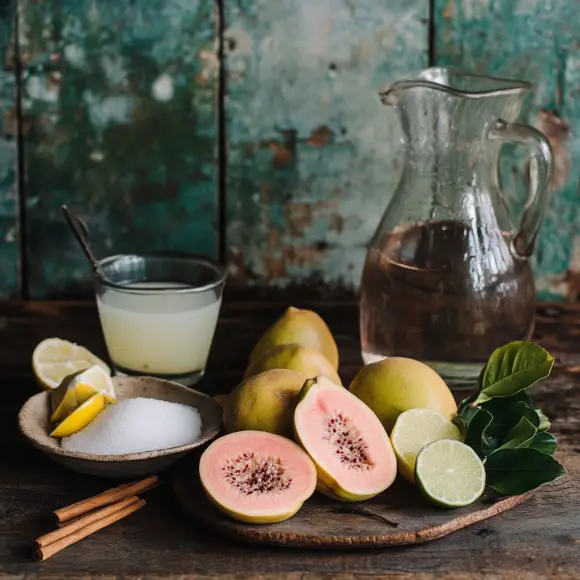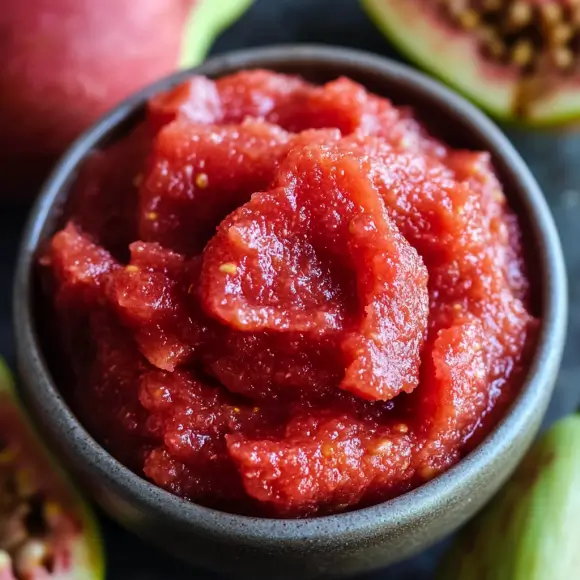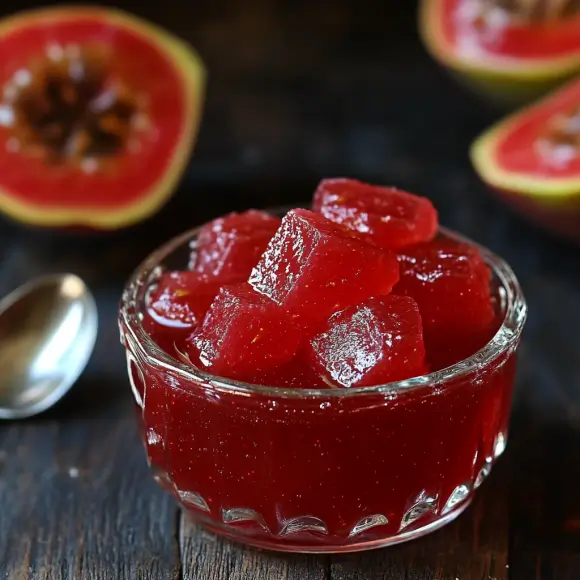- Introduction to Guava Paste: A Sweet Delight
- The Cultural Impact of Guava in Traditional Recipes
- Key Ingredients for Making Guava Paste
- Essential Equipment for Preparing Guava Paste
- Step-by-Step Guide: How to Make Guava Paste at Home
- Tips for Achieving the Perfect Texture and Flavor
- Common Variations of Guava Paste Recipes
- Popular Uses of Guava Paste in Culinary Traditions
- Health Benefits of Guava Paste
- Storing and Preserving Guava Paste
- Troubleshooting Common Issues with Guava Paste Recipes
- Pairing Guava Paste with Other Foods
- Comparing Homemade vs. Store-Bought Guava Paste
- How to Choose the Best Guavas for Guava Paste
- FAQs :
- Conclusion:
Introduction to Guava Paste: A Sweet Delight
Guava paste Recipe is a versatile and undeniably delicious tropical delight cherished across the globe. Not only is it known for its unique blend of sweetness and tanginess, but it also serves as a staple ingredient in many desserts, pastries, and savory dishes. Whether you’re an avid home cook or a culinary enthusiast, learning how to master a perfect guava paste recipe can truly improve your cooking repertoire.
What truly sets guava paste apart is its natural flavor and vibrant color, which are both derived from fresh guavas. Additionally, its dense, jelly-like consistency makes it an ideal pairing for cheeses, crackers, or even as a filling for baked goods. Moreover, it offers an opportunity to discover tropical flavors in a way that is both simple and rewarding.
If you’ve ever wondered how to make this sweet delight at home, keep reading. By the time you finish this guide, you’ll have all the tips and tricks necessary to create guava paste Recipe that rivals the best store-bought versions. Ultimately, this homemade version will add a personal and flavorful touch to your culinary creations.
The Cultural Impact of Guava in Traditional Recipes
Guava paste Recipe has roots that trace back to Latin America and the Caribbean, where guava trees thrive in tropical climates. Over centuries, this guava-based delicacy has become an integral part of many cultural cuisines.
- In Latin American countries like Brazil and Cuba, guava paste is often paired with cheese, forming the popular dessert known as “Romeo and Juliet.”
- In the Philippines, guava paste is used in traditional recipes, highlighting its versatility.
- It has also found its way into Portuguese and Spanish cuisines, emphasizing its global appeal.
The production of guava paste became widespread due to its long shelf life, making it a practical way to preserve fresh guavas. Its enduring popularity stems not only from its taste but also from the nostalgia and cultural heritage it represents.
For a broader perspective on how tropical recipes can be creatively adapted, try this bratwurst pasta recipe that showcases innovative flavor combinations.
Key Ingredients for Making Guava Paste
To create a guava paste recipe at home, you’ll need just a handful of ingredients. The simplicity of this dish is part of its charm. Here are the essentials:

Fresh Guavas: Choose ripe guavas for maximum sweetness and flavor.
Sugar: This acts as a preservative and improves the sweetness.
Lime or Lemon Juice: Adds a hint of acidity to balance the flavors.
Water: For boiling and softening the guavas.
These simple ingredients come together to create a rich and flavorful paste. For those who enjoy experimenting, additional spices like cinnamon or vanilla can be added to create a unique twist.
Looking for a similar sweet treat? Consider trying the cherry chip cake recipe, another delicious way to discover creative uses of fruit in desserts.
Essential Equipment for Preparing Guava Paste
Before starting your guava paste recipe, it’s important to have the right tools on hand. Proper equipment secures a smooth cooking process and perfect results:
- Heavy-Bottomed Pot: Prevents the paste from burning during cooking.
- Blender or Food Processor: To puree the cooked guavas into a smooth texture.
- Fine Mesh Strainer: Removes seeds and pulp for a velvety finish.
- Wooden Spoon or Spatula: For constant stirring to avoid sticking.
- Parchment Paper and Baking Dish: To set the guava paste as it cools.
Having these tools ready will make the process easier and more enjoyable, even for beginners.
Step-by-Step Guide: How to Make Guava Paste at Home
Making guava paste Recipe at home is simpler than you might think. Follow this detailed guava paste recipe:

Prepare the Guavas: Wash the guavas thoroughly, then chop them into small pieces.
Cook the Guavas: Place the guava pieces in a pot with water. Simmer until they’re soft and the flesh separates from the seeds.
Blend and Strain: Blend the cooked guavas, then strain the mixture through a fine mesh to remove seeds.
Combine with Sugar: Return the guava puree to the pot and add sugar. Stir continuously over low heat.
Add Lemon Juice: Mix in lime or lemon juice for added flavor.
Cook to Thick Consistency: Continue stirring until the paste thickens and pulls away from the sides of the pot.
Set and Cool: Pour the mixture into a parchment-lined dish and allow it to set at room temperature.
Tips for Achieving the Perfect Texture and Flavor
Creating a flawless guava paste recipe involves a few key techniques:
- Use ripe guavas: They’re sweeter and require less sugar.
- Cook on low heat: This prevents burning and secures an even texture.
- Stir constantly: Avoids sticking and uneven cooking.
- Taste test frequently: Adjust sugar and lime juice to suit your preferences.
- Allow ample cooling time: This helps the paste firm up properly.
With these tips, your guava paste will turn out smooth, flavorful, and ready to impress.
Common Variations of Guava Paste Recipes
While the classic guava paste recipe is a favorite, there are numerous variations to try:
- Spiced Guava Paste: Add cinnamon, nutmeg, or cloves for a warm flavor profile.
- Honey-Infused Guava Paste: Substitute sugar with honey for a natural sweetness.
- Low-Sugar Guava Paste: Use less sugar or opt for sugar alternatives for a healthier option.
- Guava and Mango Paste: Blend guavas with mangoes for a tropical twist.
Experimenting with these variations can help you discover a version of guava paste that suits your taste perfectly.
Popular Uses of Guava Paste in Culinary Traditions
Guava paste is incredibly versatile and can improve a variety of dishes. Here are some popular uses:
- Desserts: Use it as a filling for pastries, tarts, or cakes.
- Cheese Pairings: Serve guava paste with creamy cheeses like brie or cream cheese.
- Savory Dishes: Incorporate it into glazes for roasted meats.
- Breakfast: Spread it on toast or use it as a topping for pancakes.
- Snacks: Pair it with crackers for a quick and satisfying treat.
Whether used as a main ingredient or a complementary flavor, guava paste adds a unique touch to any dish.
Health Benefits of Guava Paste
Guava paste Recipe is not only a delicious treat but also offers numerous health benefits. Made primarily from fresh guavas, this sweet delicacy retains many of the fruit’s nutrients, making it a great addition to a balanced diet.
- Rich in Vitamin C: Guava paste contains a significant amount of vitamin C, which supports the immune system and helps combat oxidative stress.
- High in Fiber: Despite being a sweet treat, guava paste retains a decent amount of dietary fiber, which aids digestion and promotes gut health.
- Packed with Antioxidants: The natural compounds in guavas, including lycopene, act as antioxidants to reduce inflammation and fight free radicals.
- Energy Booster: The natural sugars in guava paste provide a quick source of energy, making it an ideal snack for active individuals.
Incorporating guava paste into your meals allows you to enjoy its unique flavor while benefiting from its nutritional value.
Storing and Preserving Guava Paste
Proper storage is essential to maintain the freshness and quality of your guava paste. Whether homemade or store-bought, follow these guidelines to secure longevity.
- Refrigeration: Store guava paste in an airtight container and place it in the refrigerator. This method preserves the texture and prevents spoilage.
- Freezing: For long-term storage, wrap the guava paste in plastic wrap or aluminum foil, then place it in a freezer-safe bag. Frozen guava paste can last up to 6 months.
- Room Temperature: If unopened, guava paste can be stored in a cool, dry place away from sunlight. Once opened, refrigeration is recommended.
- Avoid Moisture: Assure the paste is kept dry, as moisture can lead to mold growth and spoilage.
By following these tips, you can enjoy your guava paste recipe for weeks or even months.
Troubleshooting Common Issues with Guava Paste Recipes
Making guava paste at home can sometimes be challenging, but understanding common issues can help you perfect your guava paste recipe.
- Paste Too Runny: This often happens when the guavas are not cooked long enough. To fix it, simmer the mixture until it thickens.
- Sticky or Burnt Texture: Overcooking can cause the paste to become too sticky or even burn. Always cook on medium heat and stir continuously.
- Grainy Texture: This may occur if the guava seeds are not properly strained. Use a fine-mesh strainer to secure a smooth paste.
- Lack of Sweetness: Adjust the sugar levels to suit your taste, but remember that the natural sweetness of guavas improves the flavor.
Experimenting with these solutions secures that your guava paste turns out perfect every time.
Pairing Guava Paste with Other Foods
Guava paste Recipe is versatile and pairs wonderfully with a variety of foods, enhancing both sweet and savory dishes.
- Cheese: Pairing guava paste with cheese, such as cream cheese or manchego, creates a delightful balance of sweet and savory flavors.
- Bread and Crackers: Spread guava paste on toast, bagels, or crackers for a quick and delicious snack.
- Desserts: Use guava paste as a filling for pastries, cakes, or tarts to add a tropical twist to your desserts.
- Meat and Poultry: Guava paste can be used as a glaze or sauce for meats like pork and chicken, adding a rich and fruity taste.
Experimenting with these pairings will showcase the versatility of your guava paste recipe.
Comparing Homemade vs. Store-Bought Guava Paste
Choosing between homemade and store-bought guava paste often depends on your preferences for flavor, quality, and convenience.
- Homemade Guava Paste:
- Offers control over ingredients and sweetness levels.
- Provides a fresher taste and allows customization with spices like cinnamon.
- Requires time and effort but yields a more authentic flavor.
- Store-Bought Guava Paste:
- Convenient and ready to use.
- Typically has a longer shelf life due to preservatives.
- May lack the natural taste of fresh guavas.
Both options have their merits, but if you enjoy cooking, a homemade guava paste recipe is a rewarding experience.
How to Choose the Best Guavas for Guava Paste
The quality of your guava paste Recipe depends heavily on the type of guavas you select. Here are some tips for choosing the best fruit:
- Ripeness: Choose guavas that are fully ripe but not overly soft. Ripe guavas are fragrant and slightly firm to the touch.
- Color: Look for guavas with a bright yellow or green skin, depending on the variety. Avoid fruits with bruises or blemishes.
- Variety: Pink guavas are often preferred for guava paste due to their sweeter taste and vibrant color.
- Freshness: Always select guavas from a reliable source to assure they are fresh and free of pesticides.
By using high-quality guavas, you’ll achieve the best results with your guava paste recipe.
FAQs :
What do you do with guava paste?
Guava paste Recipe can be used in a variety of ways. It’s commonly paired with cheese, spread on bread or crackers, used as a dessert filling, or melted down into sauces and glazes for savory dishes. Its versatility makes it suitable for both sweet and savory recipes.
Can you eat guava paste by itself?
Yes, guava paste can be enjoyed on its own. Its sweet and fruity flavor makes it a delightful snack or dessert, especially when sliced into thin pieces.
What does guava paste taste like?
Guava paste has a rich, sweet taste with a hint of tartness, reminiscent of fresh guavas. The concentrated flavor makes it both bold and satisfying, perfect for complementing other ingredients.
How to thicken guava paste?
If your guava paste is too thin, simmer it over low heat, stirring continuously to evaporate excess liquid. Secure you do not overcook it, as this can lead to a sticky or burnt consistency. Using a wide pan can help speed up the thickening process.
Conclusion:
Guava paste is more than just a sweet treat; in fact, it adds versatility and nutrition to any kitchen. Not only does it offer a unique flavor profile, but it also inspires endless creativity with tropical ingredients. If you’re looking to enjoy its health benefits,discover its pairings, or create it yourself, guava paste provides a truly rewarding experience.
When you craft a guava paste recipe, you not only experience the rich flavors and vibrant colors of guavas firsthand, but you also connect with the traditions of tropical cuisine. Moreover, this process allows you to control the quality and flavor, tailoring it perfectly to your preferences. As you proceed, you’ll find that making guava paste is a simple yet fulfilling activity that brings a piece of tropical heritage into your kitchen. Furthermore, it secures that your dishes stand out with a unique and authentic touch.
So, why not give it a try? With its endless uses, undeniable charm, and the ability to improve both sweet and savory dishes, guava paste certainly deserves a permanent spot in your pantry. For example, you can pair it with cheese to create a delightful snack, use it as a filling for pastries, or even create a mouthwatering glaze for meats. Additionally, its vibrant color and fruity aroma make it a star ingredient in desserts and sauces.
Ultimately, guava paste transforms from a simple ingredient into an exciting culinary adventure. Whether you’re just beginning to try tropical flavors or you’re already a fan of guavas, this paste provides a delicious and versatile way to improve your cooking. By the time you finish your first recipe, you’ll understand why guava paste continues to captivate food lovers worldwide.
For other handy storage tips, check out this coconut cake vape recipe guide to see how different desserts can be preserved effectively.


2 thoughts on “Easy Guava Paste Recipe: Make It Perfect Every Time at Home”